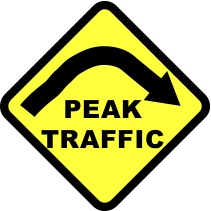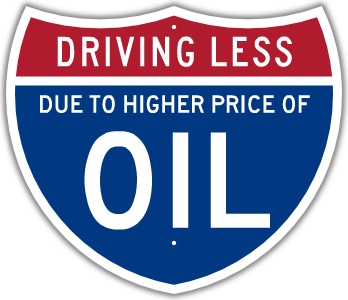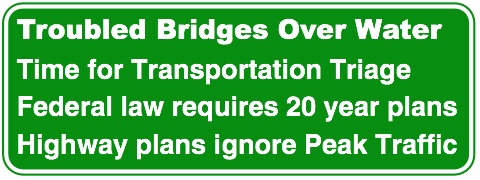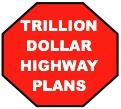Public Transit After Peak Oil
Transit projections for greater density ignore peak energy
Regarding the assumption that more density is needed for viable public transit - this is true within some scales, but as we pass Peak Oil these assumptions no longer apply. Here is a discussion about urban use of energy, density requirements for transit, and how these factors may be impacted by Peak Energy.
Public transit will be more popular and necessary after gas rationing or very expensive oil. As gas prices increased the growth of vehicle miles traveled in the US stopped and public transit systems all over the country have reported increases in usage. The total VMT hasn't declined in most places, but the increase has finally flattened out. As prices continue to oscillate steadily upwards, traditional assumptions about density and transit will probably be discarded, although that will probably take a few more years at this rate of shift. These assumptions will probably be assumed long after they're no longer fully relevant. Gas rationing and / or much more expensive oil would make transit much more popular.
During many years of freeway fighting I have had a number of professional transportation consultants (for contractors and governments) privately admit that that Peak Oil will lead to a shift in transit / land use assumptions, but none of them dare admit this in public.
Few environmental groups dare talk about this probable scenario either (after decades of awareness of Peak Oil, none of the national environmental groups yet include it in their analysis of the ecological crisis and most endorse new transportation bills to expand the National Interstate Highway system as long as there's a lesser amount of funding for public transit). Plus, most of the big national environmental groups take oil company money (called foundation grants) and they don't want to rock the boat.
I suspect that the transportation agencies will be better able to recognize the shift than will the environmental groups, since the government actually has to deal with the situation while the eco groups get their status from pontificating (which has little connection to the daily logistics of moving people around). However, those parts of the government (politicians) who seem to exist to satisfy their contributors (sand and gravel, real estate, construction, etc) will probably have the hardest time adapting to the new realities. Every species that is put into overcrowded conditions suffers for it, including human beings.
The so-called new urbanism and smart growth ideas usually fail to examine all of the other inputs into a city that make life for humans possible - food, energy, water, sewage out, etc.
If the only impact on the Earth that we have was personal transportation, then everyone should live in giant skyscrapers.
Human scale is also important for non-fascist architecture. Most skyscrapers have very little connection to human reality, even if there's a shop or two on the ground floor.
But if people want to eat fresh food (not Soylent Green), then sufficient land needs to be dedicated for local production. A good model demonstrating this does not exist anywhere I'm aware of. Perhaps suburbia after Peak Oil has the potential for it, if the lawns and parking lots are converted into food production. Food Not Lawns is probably closer to the answers than Smart Growth (which was a slogan invented to distract environmentalists from highway construction).
John Robbins wrote in Diet for a New America that a walking meat eater (getting their meat from the grocery store) uses more oil than a driving vegetarian. It would be interesting to see the energy consumption of an urban dweller who does not drive yet their food is driven very long distances versus a driver who grows much of their own food and does not require distant energy sources to heat or cool their home. (Of course, the paradigm of vegetarian bicyclists who grow their own food and use solar energy is closer to the ideal ...)
Local food production, local water, local energy, local sewage, zero waste and similar techniques would be needed to reduce the ecological footprint that a city has. Buildings use about as much energy as transportation, which means that a metropolitan area that has poor land use / transportation linkage uses about as much energy as a region that has good mass transit. In other words, while New York City has few cars and excellent public transportation, nearly everything used there is transported a long distance, which negates the lesser impact of all of those trains. A driver who eats locally might have less impact than a New York subway rider eating food from the central valley of California, but I haven't seen any calculations on that. I merely offer these examples to expand the discussion beyond personal transportation issues, which is a minority of total energy consumption and ecological impact, although probably the most obvious part of the energy puzzle.
Most "modern" cities have ecological footprints that are dozens of times larger than the city. Clearcuts in Cascadia, mountaintop removal in West Virginia, mineral mining in Nevada, deep sea drift nets in the Pacific, oil drilling in the Gulf of Mexico, copper smelters in Chile, factories in northern Mexico and eastern China, confined animal feed lots in Kansas - these and many more ecocidal activities are to fuel metropolises and must be included in analyzing the full impact of any / every urban dweller.
Public transit has many environmental impacts that must be examined as part of any alternatives analysis - the fact that a bus or train has many people on it does not make it "sustainable." Efficiency and sustainability are NOT the same thing. I've heard many well meaning people suggest that the light rail system of Portland makes that city a "sustainable" community, which is ridiculous and sad. More efficient use of non-renewable resources is better than less efficient use of those resources, but that doesn't mean the behavior can be continued generation after generation into the future. Even bicycles, the most efficient transportation ever invented, will be difficult to maintain without sophisticated metallurgy making ball bearings (a technology that seems to have completely abandoned North America, our ball bearings are made elsewhere these days).








